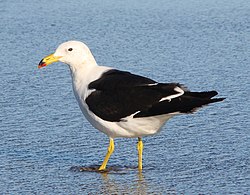| Olrog's gull | |
|---|---|
 | |
| Scientific classification | |
| Kingdom: | Animalia |
| Phylum: | Chordata |
| Class: | Aves |
| Order: | Charadriiformes |
| Family: | Laridae |
| Genus: | Larus |
| Species: | L. atlanticus |
| Binomial name | |
| Larus atlanticus Olrog, 1958 | |
 | |
Olrog's gull (Larus atlanticus) is a species of gull found along the Atlantic coast of southern Brazil, Uruguay, and northern Argentina. It was formerly considered a subspecies of the very similar L. belcheri . It is a large gull with a black back and wings, white head and underparts, a black band in the otherwise white tail, and a yellow bill with a red and black tip. Nonbreeding adults have a blackish head and a white eye ring. The species is named after Swedish-Argentine biologist Claes C. Olrog. [2] [3] It has a rather restricted breeding range and is threatened by habitat loss, and the IUCN has rated it as being "near threatened".

